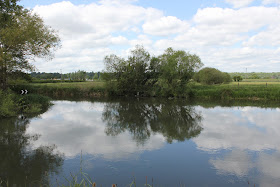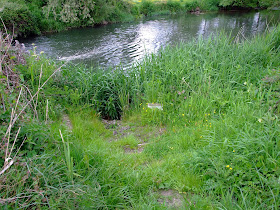Canoeists and kayakers from across the UK have been mapping where the right to paddle on the inland waterways of England and Wales is disputed, and the River Kennet, as well as its riverine remnants along the Kennet Navigation, are clearly defined by a red line running along the watercourse.
After only 7 days, members of the Song Of The Paddle website forum have already logged an impressive number of river miles where access is disputed, and, since the public only has a undisputed statutory (or licensed) right of navigation on 2,200 kms (1,400 miles) out of the 65,000 kms (41,000 miles) of main rivers over 3m wide in England and Wales, the map is likely to become ever more distinctive in this respect.
After the initial recording in green of the easier to distinguish waterways with acknowledged rights of navigation, the idea that England and Wales is a place where the public may enjoy the freedom of responsibly exercised access to and along their natural river heritage is rapidly being crossed out in red.
The River Kennet downstream from Preshute, Marlborough, and the Kennet Navigation have already been included in this new mapping project, and clearly demonstrate the restrictions that paddlers face along this ancient waterway.
May is a great time for gently canoeing and kayaking along the lower reach of the River Kennet. Winged wildlife abounds, and paddling provides a perfect platform to get up close without becoming intrusive.
All the usual residents such as Canada and Greylag Geese, and Mute Swans are easily spotted, often with young in tow.
For the sharp-eyed (spot the birdie)...
...the Grey Heron will be commonly spotted on the River Kennet.
Kingfishers are also relatively common along much of the Kennet, and nest at a number of locations. The 2005 Berkskire Ornithological Society Kingfisher survey concluded that "the probable number of breeding Kingfishers in Berkshire 2005 was between 78 and 84". It also noted that "a number of records came from canoeists; this seems to be a good way of observing Kingfishers at close quarters!" However please note that disturbance of kingfishers on or near an active nest is an offence so, if you're lucky enough to spot such a site, keep your distance to avoid being the cause of parents abandoning chicks or eggs.
Less popular, at least with fishermen, are the Cormorants that can often be seen in the skys or on perches, especially close to the many stocked lakes past which the river weaves its way.
At the other end of the size scale, reed margins on Kennet backwaters offer the paddler the chance to spot male Reed Buntings in full breeding colours at this time of year.
Aquatic invertebrates are also notable along the Kennet, and the richness of species forms part of the basis for the SSSI citation.
As the name suggests, this month sees the start of the Mayfly hatch. Pollution sensitive, the larger the numbers, the healthier the river. This one, my wife tells me, is Ephemera danica. As she is someone who was delighted to find the shed larval husk of a Mayfly, I'm not going to argue.
This is another example which we think might be the same species but as confirmation requires examination of genitalia I'll be happy if you wish to correct me.
More attractive to my eye (and also noted in the SSSI citation for the River Kennet) are the Banded and the Beautiful Demoiselle that, along with other species of Damselfly, fly in profusion along the Kennet from May through to August or early-September.
Male Banded Demoiselle, distinguished by the 'thumbprint' on its wings.
Female Banded Demoiselle.
Mating Beautiful Demoiselles (the female can be distinguished by her brown wings and metallic green body).
Male Common Blue Damselfly.
Another type of Common Blue, this is the female of our most prolific Blue butterfly species that can be found along grassland banks by the Kennet from May through to October...
...whilst the unmistakable Cinnabar Moth is another May arrival along the water side.
The Small Skipper butterfly is easy to distinguish along the banks of the River Kennet. This one is a male, identified by the black stripe on it's upper wing.
Once you know that the markings on the upper wing are said to resemble the elongated nose and chin of a 16th Century witch, you will never have a problem identifying the Mother Shipton moth as you paddle down the River Kennet (more on persecuted paddling witches on the River Kennet at a later date).
Edited with additional images 21.05.11
The obstruction that used used to greet paddlers at SU 617 684 is no more. The partially collapsed bridge that formerly provided access to the West Meadow island was a magnet for tree debris on the section of the riverine Kennet shortly before it rejoins the Navigation after Ufton Road bridge.
Approaching the bridge in summer 2009. The size of the blockage is attested to by the amount of green growth.
When viewed from downstream the cause of the blockage was more apparent and the squeeze through river left is just visible.
Even die-back and winter flows failed to dislodge the blockage, leaving a potentially nasty hazard to navigation.
Riparian landowners have an obligation to ensure river blockages are removed, and in this instance it must have been no little effort to take out the collapsed bridge section.
There are now no structural bars to navigation by canoe and kayak along the 2.9 km (1.8 mile) run from below Padworth Mill to Ufton...
...although branches in the river are still frequent and occasional larger tree falls persist.
In part a continuation of my post on 21.03.10, two 'events' are looking likely to have a serious impact on the health and paddling potential of the riverine Kennet in the coming months.
The first 'event' is the weather, and the reported fact that "April was a very remarkable month in hydrometeorological terms: provisionally it was the warmest April in the 352-year Central England Temperature series, estimated (river) outflows from Britain were the lowest on record for the last week of April, and the end-of-month soil moisture deficits were the highest (for England & Wales) in a 50-year series." [1]
An employee of the Centre for Ecology & Hydrology has further stated that “Historical rainfall figures indicate a tendency for dry spring periods to be followed by above average summer rainfall, but with evaporation rates increasing even average summer rainfall would imply very low late summer river flows – and an associated major contraction in the river network.” [2]
The non-canalised sections of the lower reach of the River Kennet are already beginning to show signs that increased levels of consideration need to be made when planning to paddle off the beaten track of the Navigation, both in terms of environmental conditions and resultant requirements for alternative access.
A couple of strolls around the vicinity of the Old Mill at Aldermaston yesterday evening and this afternoon illustrated some of the issues for paddlers.
The portage around the small but un-runnable weir fed by the canalised flow above the main property - and which avoids the main channel by means of a side stream (supported by the confluence with the River Enborne) - is still entirely viable. Potential concern about the current thin reed line may be tempered by consideration of what will happen after the fishing season opens (see image from Oct. '09 in link above).
However, whilst the weir pool is deep enough...
...just downstream the water levels are looking rather low. Whilst this might be beneficial in terms of getting under the low hanging tree branch at the River Enborne confluence, the water level might present issues of potential contact with the river bed. Consideration should always be given to areas of clean gravel bed with fast flowing water where Barbel may have recently spawned (normally between May and July): "The young Barbel hatch within a week , but unlike other coarse fish the young remain in the gravel for several weeks, surviving first off their large yolk sack, and then actively hunting tiny invertebrates in the spaces amongst the gravel." [3]
In seeking to portage this low level section it would be possible to follow the side stream after the River Enborne confluence by the public footpath to the point where it reaches the lower edge of the Old Mill at Aldermaston fishery, and the confluence with the main channel below the sluiced weir.
Alternatively, you might haul your boats a little further along the public footpath, carefully cross the B430 Basingstoke Road, and put in to the river below the road bridge just off the public footpath...
...except for the fact you would now be on Wasing Estate land that continues to warn against accessing the river from its property. More about this estate and its owner in a coming post.
The second 'event' that will have a significantly negative impact on the whole of the River Kennet is the Environment Agency's renewal of Thames Water's Axford abstraction licence until March 2013. Reported online in Newbury Today, the current position would appear to be that the EA is being held over a legal barrel until it saves up/coughs up £10m.
Taken to its logical, absurd and disgusting conclusion, this situation is likely to be repeated until either the aquifer is unable to respond to the abstraction requirement (by which time the upper River Kennet will have ceased to exist) or Thames Water persuades its owners in Australia, Macquarie Group Limited, that its admirable efforts in leading the Upper Kennet Restoration Project should be considered as more than a token gesture.
[1] Source: http://www.ceh.ac.uk/news/news_archive/april-hydrological-summary_2011_28.html
[2] Source: ibid.
[3] Source: http://www.fishing.co.uk/species_display.php3?id=1
































